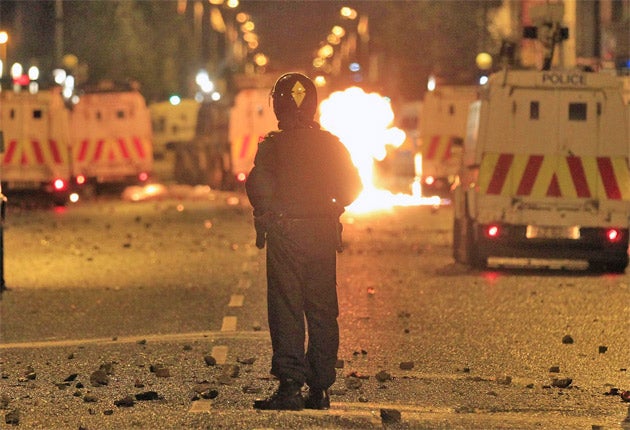Short Strand: An enclave stranded in a sea of loyalist hatred
The Catholic district at the heart of this week's unrest has long been a touchpaper for sectarian strife

As a district, Short Strand is literally stranded, a small island of green in a surrounding Orange ocean, the only sizeable Catholic enclave in predominantly Protestant east Belfast.
Click HERE to view graphic (179k jpg)
The west and north of the city have large Catholic areas, but Short Strand is cut off from the rest of Catholic Belfast by the River Lagan.
Although it is heavily outnumbered in religious terms, the district has attracted much resentment from some of the adjacent Protestants. The reasons go back into history: it sits close to the now almost defunct shipyard, symbol of the old Protestant industrial ascendancy.
The general area also has an additional religious significance in that it is one of the city's major traditional rallying points for Orange marches.
Passing parades have often been a source of disorder, with rival allegations flying when trouble starts.
After one major clash, a Belfast Catholic newspaper famously carried a headline accusing an Orange march of attacking Short Strand. The same day's Protestant paper meanwhile declared that Short Strand had attacked the march.
Another source of friction is the fact that the local Catholic church, St Matthew's, occupies a prominent position on one of the main routes from the city centre into east Belfast. One resident said: "Our church offends them."
When it was founded in 1831 the congregation was small and community relations were good, with "a number of most respectable Protestants present" at its opening. But as numbers grew – a priest spoke approvingly of "our swarming children" – relations deteriorated as Catholics came to be perceived as a threat.
Sectarian skirmishes developed, so much so that the army and police were often called in: at some points the congregation went to church, it was said, "practically behind a hedge of bayonets". A century ago a priest described it as "surrounded by coarse, savage enemies in numbers 10 to one".
In 1970 the church grounds were the scene of a major gun battle, with IRA members and invading loyalists exchanging gunfire, an event that allowed the IRA to claim a status as defenders of isolated Catholics.
That episode and others like it were meant to impress on loyalists that the Short Strand, though small, was not defenceless. That message was reinforced this week when shots were fired from the district, hitting two Protestant youths.
Over the years trouble has come on both major and minor scales. In 2002, disturbances lasted months, leaving many locals on tranquilliser tablets.
The church, meanwhile, has continued to function as a place of worship, though its front is generally closed up so that parishioners enter and leave discreetly, avoiding the main road.
In March this year, loyalists splashed its frontage with red, white and blue paint. The church itself illustrates the local siege mentality, declaring on its website: "Since it was consecrated in 1831 until the present day the parishioners have experienced generations of hardship and suffering, engaging in a continuous battle for survival against poverty, unemployment and sectarianism."
But while this week's rioting suggests that this cheerless continuum is being maintained, in some ways the narrative is changing.
Although the peace process has hugely benefited Northern Ireland as a whole, neither Short Strand nor the adjacent Protestant districts have experienced a major peace dividend.
But Short Strand is a much more energetic place, socially and politically. The Lord Mayor of Belfast, for example, is a local Sinn Fein member, Niall O Donnghaile, elected last month aged just 25. His communications skills are better than those of the loyalists in the balaclavas who this week attacked both Short Strand and the police.
The loyalists have proved hopeless at articulating their grievances and have yet to spell out why they went on the rampage. Much nearby Protestant territory is shabby and neglected. The high unemployment is a far cry from the days when jobs for Protestants were plentiful in the shipyard less than half a mile away.
Over the years many of the more go-ahead Protestants have migrated to less rundown districts. They left behind many of the less-educated youth and a district plagued with crime, drugs and other inner-city problems.
It also leaves them prey to paramilitary groups, one of the few routes to street status. But this path often leads them to prison and to street violence of the type seen this week. In the old days in east Belfast, Protestants used to call the shots, politically and economically. Now they just call the shots.
The riots are probably as much directed against the police as symbols of authority as they were against Short Strand, for many loyalists feel excluded from the peace process.
There is a dual isolation here: for Short Strand it is geographical, but for the loyalists it is political and thus goes much deeper.
Subscribe to Independent Premium to bookmark this article
Want to bookmark your favourite articles and stories to read or reference later? Start your Independent Premium subscription today.
